News
Families, animals, suffer in a parched land
As drought tightens its grip in the north and east, drinking water now has to be distributed daily. Cattle lie dead on the roads. In the Yala jungle, wildlife walk long distances in search of water.
“Our village is suffering from a severe shortage of drinking water. People in this area have no time to work or study because they spend the whole day in search of drinking water. Our infants are crying of thirst at night but we cannot go out as elephants are there in the Pannal Oya,” laments Sujith Priyantha from Kumana.
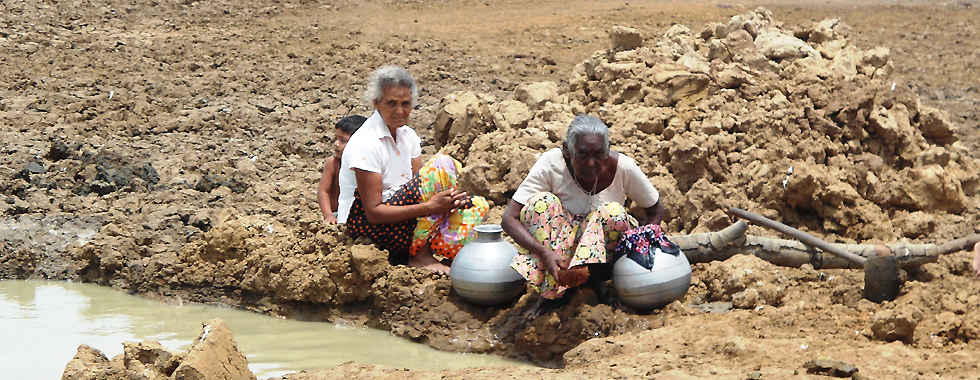
Polonnaruwa: Young or old no one is spared the harsh reality of scarcity of drinking water (far left and above). Pix by Karu Gamage
It is not only the drinking water that is troubling thousands of farmers like Priyantha in the Ampara district. The drought has dried up the only small oya that supplies water to his paddy cultivation.
With no income and no water, drought-hit rural areas are suffering from extreme poverty, thirst and hunger.
People in the Northern, North Central, Eastern and Uva provinces continued their battle for water last week while, paradoxically, heavy rain lashed across the Western, Southern and Sabaragamuwa areas.
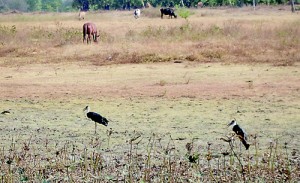
The dried up Ibbankatuwa Wewa in Dambulla. Pic by Kanchana Kumara Ariyadasa
Women using coconut shells to collect water from dried-up wells, people running behind water bowsers to collect water, long queues to collect water, dead cattle on dried and dusty roads – these are now common sights in these districts.
Ampara GA Neil de Alwis said all divisional secretaries in affected areas have been instructed to provide details of paddy farmers whose livelihood had been affected in order to provide relief for them. He said drinking water is being provided on a daily basis.
“As the water in the Yala wild life reserve’s water sources have dried up, animals are seen walking long distances in search of water,” he added.
The Irrigation Department warns of falling water levels in tanks. Janaki Meegasthenna, Director (Water Management) of the Irrigation Department said that two weeks ago the water levels were 20 per cent and last week they had fallen to 10
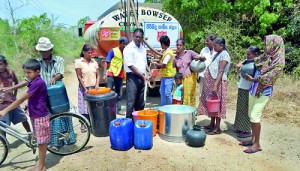
Waiting for water: Salvation Army comes to the rescue of residents in Welikanda
per cent.
“This is a critical stage. The department is presently pumping from down streams and has cut waterways leading to sluices. In Ampara, almost all the AGA divisions are affected due to the drying of the Senanayake Samudraya. In Hambantota, the Weeraketiya and Lunugamvehera areas are also affected,” she said.
The government has allocated Rs. 1.9 billion to provide relief to people in drought-hit areas, Disaster Management spokesperson Sarath Lal Kumara said.
The assistance includes provision of water and dry rations as well as purchase containers and plastic tanks to store water.
“If this drought condition continues for a few months, there will be an emergency situation,” Mr Kumara said.
He said 14 districts including Ampara, Anuradhapura, Hambantota, Trincomalee, Vavuniya, Mullaitivu, Kilinochchi, Moneragala, Batticaloa, Puttalam, Polonnaruwa districts are burdened by the severe water shortage.
The National Water Supply and Drainage Board has despatched all its bowsers to Hambantota, Moneragala, Anuradhapura, Polonnaruwa and Vavuniya districts along with 300 plastic storage tanks.
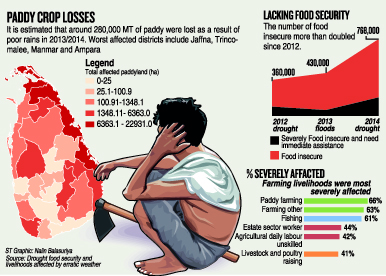 “The Board is hoping to hire more bowsers for Trincomalee and Ampara districts where there is a growing severe shortage of drinking water,” said Water Board General Manager Ranjith Balasuriya.
“The Board is hoping to hire more bowsers for Trincomalee and Ampara districts where there is a growing severe shortage of drinking water,” said Water Board General Manager Ranjith Balasuriya.
He said the agriculture sector is set to suffer great losses as most of the tanks had dried up. “Now the main issue is drinking water that has to be provided on a daily basis,” he said.
District Secretaries (Government Agents) in these areas are struggling with the increased workload of hiring bowsers, providing plastic barrels and organising dry rations and prepared food for those affected.
“We have received Rs. 315 million in order to distribute water in bowsers several times a day. Plastic tanks have been distributed. In order to reach the rural population more assistance is needed especially in terms of plastic water tanks, bottled water and so on,” said 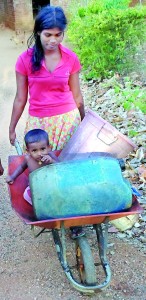 Anuradhapura GA Mahinda Seneviratne.
Anuradhapura GA Mahinda Seneviratne.
He said the Medawachchiya, Mahawilachchiya, Padaviya, Kebethigollewa and Horowpathana areas were the worst affected.
Polonnaruwa GA Nimal Abeysiri said in his region, Welikanda, Medirigiriya, Hingurakgoda, Lankapura, Elahera, Dimbulagala were among the five AGA divisions most severely affected.
“Daily, 40,000 litres of water are distributed through 14 bowsers. Unfortunately villagers in the rural areas do not have wide-mouthed 50-litre or 100-litre barrels to collect and store water,” he said.
Moneragala district is enduring severe drought conditions, with over 32,000 families in the district affected, mainly in Thanamalwila, Wellawaya, Buttala, Moneragala, Siyambalanduwa, Bibile and Medagama.
Drinking water is provided daily to 114 grama niladhari divisions in Moneragala.
Cash-for-work and food-for-work programmes are also underway in the district, Government Agent A. Pathiananthan said; adding that organisations such as the World Food Programme were helping to provide relief.
In Trincomalee, the areas of Surangal, Maniarasankulam and Ayiliyadi are experiencing severe water shortage. In Mullaitivu, Maankulam, Oddusuddan, Mallavi, Puthukkudiyiruppu are hard hit by the prevailing dry spell.
(Additional reporting by Ampara correspondent Wasantha
Chandrapala)

